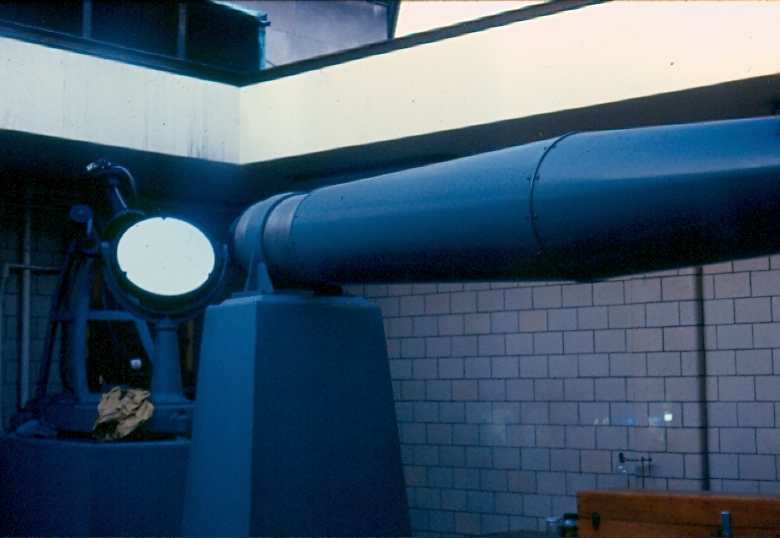
Photograph of the spaceship depicted
in the 1960s science-fiction television
series, "Lost in Space," where a family
had launched from Earth in 1997 for a
voyage to a planet orbiting the closest star,
Alpha Centauri. Now, scientists hope to
send an unmanned probe to the Alpha
Centauri star system within a generation.
(Image Source: Pinterest.com )
By Lee Billings, Scientific American
For Yuri Milner, the Russian Internet entrepreneur and billionaire philanthropist who funds the world’s richest science prizes and searches for extraterrestrial intelligence, the sky is not the limit—and neither is the solar system. Flanked by physicist Stephen Hawking and other high-profile supporters in New York, Milner announced his most ambitious investment yet: $100 million toward a research program to send robotic probes to nearby stars within a generation.
“The human story is one of great leaps,” Milner said in a statement released shortly before the announcement. “55 years ago today, Yuri Gagarin became the first human in space. Today, we are preparing for the next great leap—to the stars.”
“Breakthrough Starshot,” the program Milner is backing, intends to squeeze all the key components of a robotic probe—cameras, sensors, maneuvering thrusters and communications equipment—into tiny gram-scale “nanocraft.” These would be small enough to boost to enormous speeds using other technology the program plans to help develop, including a ground-based kilometer-scale laser array capable of beaming 100-gigawatt laser pulses through the atmosphere for a few minutes at a time, and atoms-thin, meter-wide “light sails” to ride those beams to other stars. Each pinging photon of light would impart a slight momentum to the sail and its cargo; in the microgravity vacuum of space, the torrent of photons unleashed by a gigawatt-class laser would rapidly push a nanocraft to relativistic speeds.
"Without new methods of propulsion we simply cannot get very far," Hawking said at the announcement. "Light is the most pragmatic technology available."
Deployed by the thousands from a mothership launched into Earth orbit, each nanocraft would unfurl a sail and catch a laser pulse to accelerate to 20 percent the speed of light—some 60,000 kilometers per second. Using a sophisticated adaptive-optics system of deformable mirrors to keep each pulse coherent and sharp against the blurring effects of the atmosphere, the laser array would boost perhaps one orbiting nanocraft per day. Each laser pulse would contain as much power as that produced by a space shuttle rocketing into orbit.
The array would need to be built at a dry, high-altitude location in the Southern Hemisphere, perhaps on a peak in Chile, South Africa or even Antarctica—somewhere within sight of Breakthrough Starshot’s primary targets: the twin stars of Alpha Centauri, which at 4.37 light-years away make up the nearest neighboring star system to our own. NASA has already sent five spacecraft on trajectories taking them beyond our solar system, although even the fastest of these would require more than 30,000 years to reach Alpha Centauri. The nanocraft would make that same interstellar crossing in just 20 years. With no onboard ability to decelerate, they would briefly gather data about any planets in the Alpha Centauri system and beam it back toward Earth before plunging deeper into interstellar darkness and out of communication range.
More - Link >>> http://www.scientificamerican.com/article/100-million-plan-will-send-probes-to-the-nearest-star1/
More on Project Breakthrough Starshot:
Link >>> https://en.wikipedia.org/wiki/Breakthrough_Starshot
Related Blog Posts ---
"Laser Propulsion: Earth To Mars in 3 Days?" 2016 Feb. 25.
Link >>> http://spacewatchtower.blogspot.com/2016/02/laser-propulsion-earth-to-mars-in-3-days.html
"Supersonic Laser Propulsion." 2014 Nov. 13.
Link >>> http://spacewatchtower.blogspot.com/2014/11/supersonic-laser-propulsion.html
Source: Scientific American Magazine.
2016 April 14.
May 9 - Safe Public Viewing of Rare Astronomical Event

2016: 75th Year of Pittsburgh's Buhl Planetarium Observatory
Link >>> http://spacewatchtower.blogspot.com/2016/01/astronomical-calendar-2016-january.html
Like This Post? - Please Share!
Want to receive SpaceWatchtower blog posts in your inbox ?
Send request to < spacewatchtower@planetarium.cc >..
gaw
Glenn A. Walsh, Project Director,
Friends of the Zeiss < http://buhlplanetarium.tripod.com/fotz/ >
Electronic Mail - < gawalsh@planetarium.cc >
SpaceWatchtower Blog: < http://spacewatchtower.blogspot.com/ >
Also see: South Hills Backyard Astronomers Blog: < http://shbastronomers.blogspot.com/ >
Barnestormin: Writing, Essays, Pgh. News, & More: < http://www.barnestormin.blogspot.com/ >
About the SpaceWatchtower Editor / Author: < http://buhlplanetarium2.tripod.com/weblog/spacewatchtower/gaw/ >
SPACE & SCIENCE NEWS, ASTRONOMICAL CALENDAR:
< http://buhlplanetarium.tripod.
Twitter: < https://twitter.com/spacewatchtower >
Facebook: < http://www.facebook.com/pages/
Author of History Web Sites on the Internet --
* Buhl Planetarium, Pittsburgh:
< http://www.planetarium.
* Adler Planetarium, Chicago:
< http://adlerplanetarium.
* Astronomer, Educator, Optician John A. Brashear:
< http://johnbrashear.tripod.com >
* Andrew Carnegie & Carnegie Libraries:
< http://www.andrewcarnegie.
* Civil War Museum of Andrew Carnegie Free Library:
< http://garespypost.tripod.com >
* Duquesne Incline cable-car railway, Pittsburgh:
< http://inclinedplane.tripod.
* Public Transit:
< http://andrewcarnegie2.tripod.
Many thanks for the exciting blog posting! I really enjoyed reading it, you are a brilliant writer. I actually added your blog to my favorites and will look forward for more updates. Great Job, Keep it up
ReplyDeletedentist reading